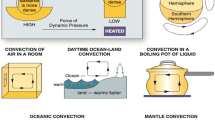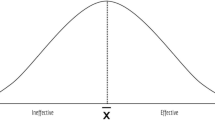Abstract
We report the effect of different sequences of high vs low levels of instructional guidance on children’s immediate learning and long-term transfer of simple experimental design procedures and concepts, often called “CVS” (Control of Variables Strategy). Third-grade children (N = 57) received instruction in CVS via one of four possible orderings of high or low instructional guidance: high followed by high (HH), high followed by low (HL), low followed by high (LH), and low followed by low (LL). High guidance instruction consisted of a combination of direct instruction and inquiry questions, and low guidance included only inquiry questions. Contrary to the frequent claim that a high degree of instructional guidance leads to shallow learning and transfer, across a number of assessments—including a 5-month post-test—the HH group demonstrated a stronger understanding of CVS than the LL group. Moreover, we found no advantage for preceding high guidance with low guidance. We discuss our findings in relation to perspectives advocating “invention as preparation for future learning”, and the efficacy of “productive failure”.




Similar content being viewed by others
Notes
Five children dropped out of the study between the early and later phases, leaving 52 children who were included in the entire study: Ns in each group were HH = 14, HL = 11, LH = 14, LL = 13.
Mean time on task four the four set-ups in the High Guidance condition was 9:15 and for the eight set-ups in the Low Guidance condition 14:33.
Recall that in the Low guidance condition, there were two experiments to assess the effect of each of the four variables. In order to minimize redundancy and potential disengagement in Phase 4, the procedure was slightly truncated whenever children’s responses indicated that they had already learned how to test for a specific variable. More specifically, if a child’s first experimental design for a specific variable was unconfounded, then the second opportunity to test this variable was skipped—because the child had already mastered CVS. All HL children and five children LL children exhibited this pattern.
Children tested each variable separately. For example, children designed two cars to test a binary variable (score of 1 possible), three cars to test a ternary variable (score of 2 possible), etc.
All post hoc between-subject comparisons are Tukey-adjusted.
References
Chen, Z., & Klahr, D. (1999). All other things being equal: Acquisition and transfer of the control of variables strategy. Child Development, 70, 1098–1120.
Chen, Z., & Klahr, D. (1999). Remote transfer of scientific reasoning and problem-solving strategies in children. In R. V. Kail (Ed.), Advances in child development and behavior (Vol. 36, pp. 419–470). Amsterdam: Elsevier.
Chinn, C. A., & Malhotra, B. A. (2001). Epistemologically authentic scientific reasoning. In K. Crowley, C. D. Schunn, & T. Okada (Eds.), Designing for science: Implications from everyday, classroom, and professional settings (pp. 351–392). Mahwah, NJ: Erlbaum.
Dean, D., & Kuhn, D. (2007). Direct instruction vs. discovery: The long view. Science Education, 91, 384–397.
Gentner, D., Levine, S., Dhillon, S., & Poltermann, A. (2009). Using structural alignment to facilitate learning of spatial concepts in an informal setting. In B. Kokinov, K. Holyoak, & D. Gentner (Eds.), Proceedings of the second international conference on analogy. Sofia: NBU Press.
Germann, P. J., Aram, R., & Burke, G. (1996). Identifying patterns and relationships among the responses of seventh-grade students to the science process skill of designing experiments. Journal of Research in Science Teaching, 33, 79–99.
Kalyuga, S. (2007). Expertise reversal effect and its implications for learner-tailored instruction. Educational Psychology Review, 19, 509–539.
Kalyuga, S., Chandler, P., Tuovinen, J., & Sweller, J. (2001). When problem solving is superior to studying worked examples. Journal of Educational Psychology, 93, 579–588.
Kalyuga, S., & Sweller, J. (2004). Measuring knowledge to optimize cognitive load factors during instruction. Journal of Educational Psychology, 96, 558–568.
Kapur, M. (2008). Productive failure. Cognition and Instruction, 26, 379–424.
Kapur, M. (2009). Productive failure in mathematical problem solving. Instructional Science, 38, 523–550.
Kirschner, P. A., Sweller, J., & Clark, R. E. (2006). Why minimal guidance during instruction does not work: An analysis of the failure of constructivist, discovery, problem-based, experiential, and inquiry-based teaching. Educational Psychologist, 41, 75–86.
Klahr, D. (2009). “To every thing there is a season, and a time to every purpose under the heavens”: What about direct instruction? In S. Tobias & T. M. Duffy (Eds.), Constructivist theory applied to instruction: Success or failure?. New York: Taylor and Francis.
Klahr, D., & Li, J. (2005). Cognitive research and elementary science instruction: From the laboratory, to the classroom, and back. Journal of Science Education and Technology, 4, 217–238.
Klahr, D., & Nigam, M. (2004). The equivalence of learning paths in early science instruction: Effects of direct instruction and discovery learning. Psychological Science, 15, 661–667.
Klahr, D., Triona, L. M., & Williams, C. (2007). Hands on what? The relative effectiveness of physical versus virtual materials in an engineering design project by middle school children. Journal of Research in Science Teaching, 44, 183–203.
Koedinger, K. R., & Aleven, V. (2007). Addressing the assistance dilemma in experiments with cognitive tutors. Educational Psychology Review, 19, 239–264.
Kuhn, D. (2007). Is direct instruction an answer to the right question? Educational Psychologist, 42, 109–113.
Kuhn, D., Amsel, E., & O’Loughlin, M. (1988). The development of scientific thinking. San Diego, CA: Academic Press.
Kuhn, D., & Dean, D. (2005). Is developing scientific thinking all about controlling variables? Psychological Science, 16, 866–870.
Kuhn, D., Garcia-Mila, M., Zohar, A., & Andersen, C. (1995). Strategies of knowledge acquisition. Monographs of the Society for Research in Child Development, 60(4), 137–151.
Lorch, R. F., Jr, Lorch, E. P., Calderhead, W. J., Dunlap, E. E., Hodell, E. C., & Freer, B. D. (2010). Learning the control of variables strategy in higher- and lower-achieving classrooms: Contributions of explicit instruction and experimentation. Journal of Educational Psychology, 1, 90–101.
McDaniel, M. A., & Schlager, M. S. (1990). Discovery learning and transfer of problem-solving skills. Cognition and Instruction, 1990(7), 129–159.
National Research Council. (1996). The National Science Education Standards. Washington, DC: National Academy Press.
Roll, I., Aleven, V., & Koedinger, K. R. (2009). Helping students know ‘further’—Increasing the flexibility of students’ knowledge using symbolic invention tasks. In N. A. Taatgen & H. van Rijn (Eds.), Proceedings of the 31st annual conference of the Cognitive Science Society (pp. 1169–1174). Austin, TX: Cognitive Science Society.
Schwartz, D. L., & Bransford, J. (1998). A time for telling. Cognition and Instruction, 16, 475–522.
Schwartz, D. L., Chase, C. C., Oppezzo, M. A., & Chin, D. B. (2011). Practicing versus inventing with contrasting cases: The effects of telling first on learning and transfer. Journal of Educational Psychology, 103, 759–775.
Schwartz, D. L., & Martin, T. (2004). Inventing to prepare for future learning: The hidden efficiency of encouraging original student production in statistics instruction. Cognition and Instruction, 22, 129–184.
Strand-Cary, M., & Klahr, D. (2009). Developing elementary science skills: Instructional effectiveness and path independence. Cognitive Development, 23, 488–511.
Sweller, J. (1988). Cognitive load during problem solving: Effects on learning. Cognitive Science, 12, 257–285.
Taber, K. S. (2010) Constructivism and direct instruction as competing instructional paradigms: An essay review of Tobias and Duffy’s constructivist instruction: Success or failure? (Vol. 13, No. 8) New York: Routledge.
Tobias, S., & Duffy, T. M. (2009). Constructivist instruction: Success or failure? New York: Routledge.
Toth, E., Klahr, D., & Chen, Z. (2000). Bridging research and practice: A cognitively based classroom intervention for teaching experimentation skills to elementary school children. Cognition and Instruction, 18, 423–459.
Triona, L. M., & Klahr, D. (2003). Point and Click or Grab and Heft: Comparing the influence of physical and virtual instructional materials on elementary school students’ ability to design experiments. Cognition & Instruction, 21, 149–173.
Zimmerman, C. (2007). The development of scientific thinking skills in elementary and middle school. Developmental Review, 27, 172–223.
Acknowledgments
The research reported here was supported in part by the Institute of Education Sciences, U.S. Department of Education, through grants R305B040063 and R305A100404 to Carnegie Mellon University. The opinions expressed are those of the authors and do not represent views of the Institute or the U.S. Department of Education. Thanks to Howard Seltman, Anna Fisher, Marsha Lovett, Stephanie Siler, and Miriam Novack for their comments and suggestions on earlier version of this paper. We also thank the teachers and students of The Campus School at Carlow University and Sacred Heart Elementary School for their enthusiastic cooperation throughout the project.
Author information
Authors and Affiliations
Corresponding author
Rights and permissions
About this article
Cite this article
Matlen, B.J., Klahr, D. Sequential effects of high and low instructional guidance on children’s acquisition of experimentation skills: Is it all in the timing?. Instr Sci 41, 621–634 (2013). https://doi.org/10.1007/s11251-012-9248-z
Received:
Accepted:
Published:
Issue Date:
DOI: https://doi.org/10.1007/s11251-012-9248-z




